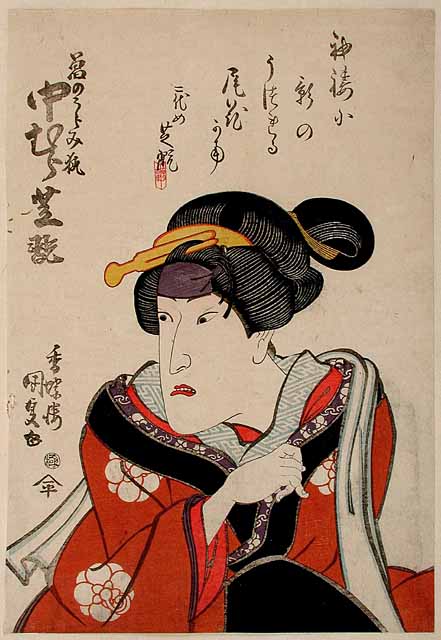
Nakamura Shikan II as Kuzo no Ha in the guise of the resentful fox-spirit (Kuzuno urami gitsune )
Kunisada 16
c. 1831
Private collection For a more detailed description
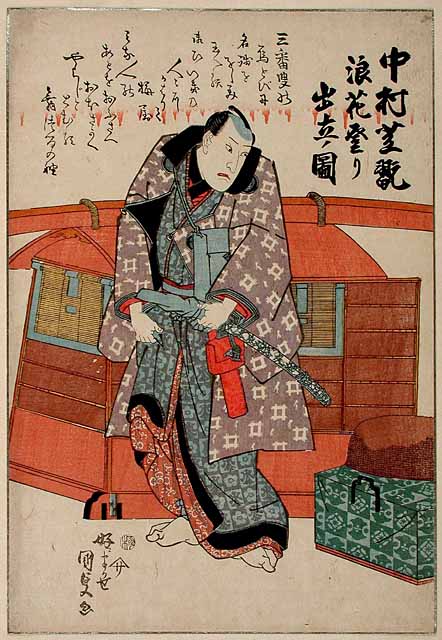
Nakamura Shikan II departing for Osaka 1833
Private collection
Nakamura Shikan II was primarily an Osaka actor but he worked for extended periods in Edo. His first sojourn in Edo ran from 1828 to 1833. At the end of 1833 Kunisada marked his departure from Edo by designing this print. This is as much a fashion plate as a commemorative print.
Shikan II is shown dressed in the latest fashion of the town before the sedan chair that will carry him away. His accoutrements are meticulously rendered, while his pose is identical to those encountered in Kunisada’s prints of beautiful women of this period.
To the right, resting on his trunk, is a rush basket, reminding us of the low legal status of actors in Tokugawa Japan: actors, along with criminals, were required to wear such baskets over their heads when passing along city streets.
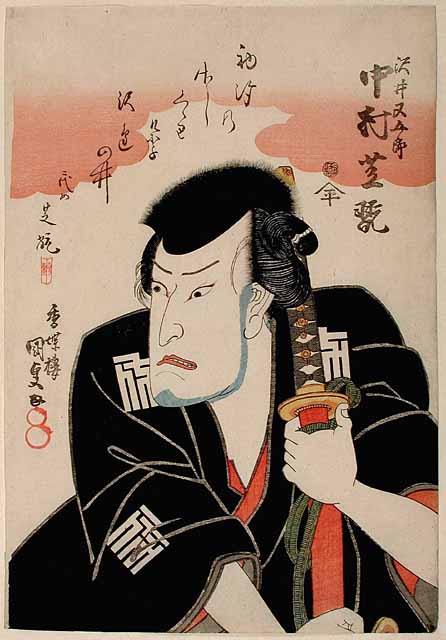
Nakamura Shikan II (later Utaemon IV) as Sawai Matagoro in Sono umayagi Sagara no Kikigaki (Things heard along the Highway to Sagara) performed at the Nakamura Theatre in 07/1831
Kunisada 7
Private collection
From an untitled set containing at least eight designs.
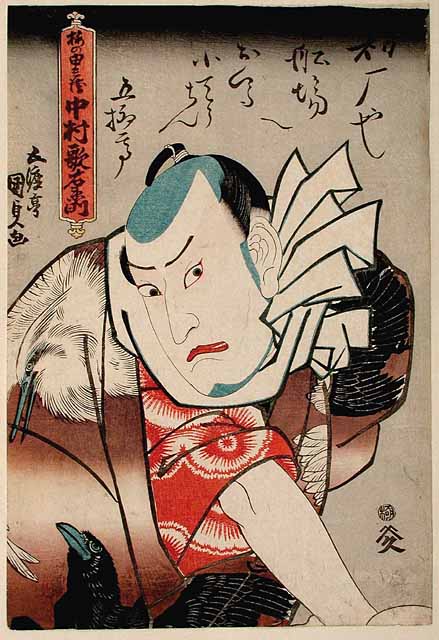
Onoe Kikugoro V as Chokichi (right) and Nakamura Utaemon IV as Yoshibei (left) in Sumida haru geisha katagi (The Character of a geisha in the Sumida Spring) performed at the Nakamura Theatre in 03/1838
The actor Shikan II was adopted by Utaemon III in 1836 and subsequently took the name Utaemon IV. The white herons and black crows on the kimono symbolising innocence and bad luck respectively immediately identify the character of Yoshibei. After saving him from a robber on the banks of the O River, Yoshibei kills the unfortunate Chokichi in order to obtain the money he is carrying; in the process his little finger is bitten off.
Yoshibei does not realise that he has killed the younger brother of his wife Koume. When Koume sees the missing finger in the corpse’s mouth, she realises her husband is responsible. To bear the guilt herself she cuts off her own finger and kills herself.
The impetuous Yoshibei and the gentle Chokichi are strongly contrasted in these prints. Each can stand by itself, but when they are paired they make a very effective diptych.
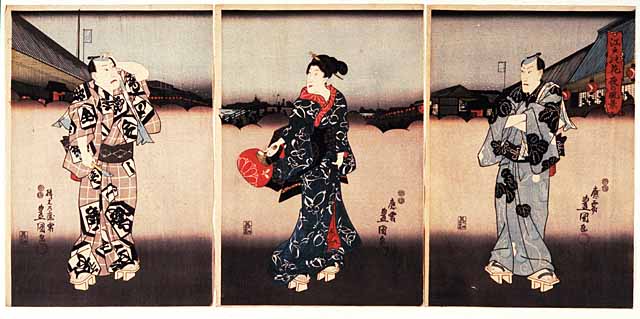
Edo no hana yoru no fukei (Flowers of Edo: A Night View)
Kunisada 34
c.1847-52
Given by the Friends of the Fitzwilliam with the aid of the MGC Purchase Grant Fund and the National Art Collections Fund.
A triptych showing three leading Edo (Tokyo) actors of the 1840s in summer kimono: Ichikawa Danjuro VIII (right), Bando Shuka I (centre) and Nakamura Utaemon IV (left).
Collections Record: P.57-1999
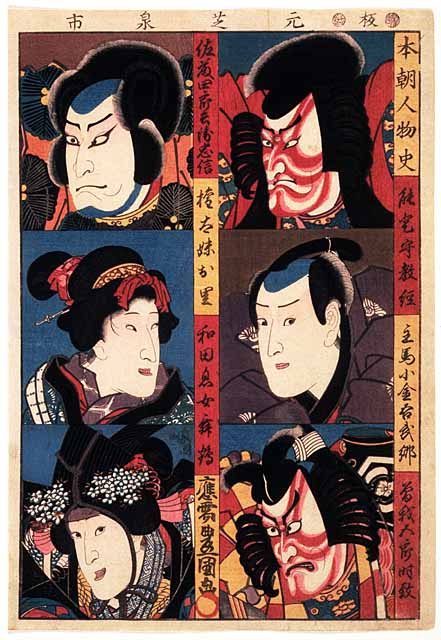
Honcho jimbutsu shi (Historical Personages of Our Land)
Kunisada 35
c. 1847
Given by the Friends of the Fitzwilliam with the aid of the MGC Purchase Grant Fund and the National Art Collections Fund
A print comprising bust portraits of six leading actors:
Nakamura Utaemon IV (top left); Seki Sanjuro III (top right);
Bando Shuka I (center left); Ichimura Uzaemon XII (centre right);
Fujikawa Kayu (bottom left); Ichikawa Ebizo V (bottom right).
The portraits were mostly derived from full-sized oban (full-sheet) prints that Kunisada had designed some years earlier.
Collections Record: P.58-1999
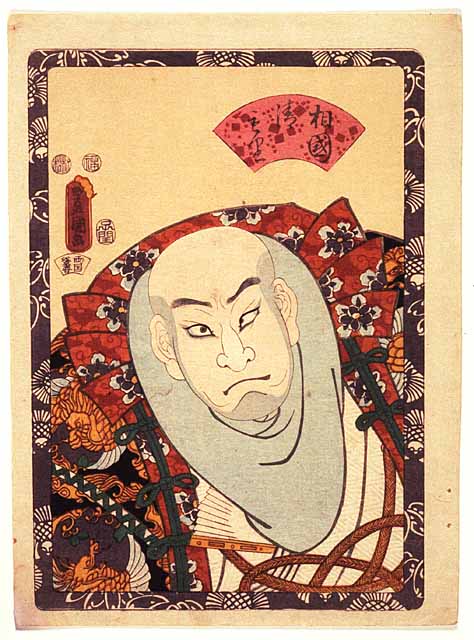
Shokoku Kiyomori (First Minister Kiyomori)
02-03/1852
Given by the Friends of the Fitzwilliam with the aid of the MGC Purchase Grant Fund and the National Art Collections Fund
Published by Kamaya Kihei, this is one of a series of memorial portraits (tsuizen-e) of Nakamura Utaemon IV that appeared soon after his death in 02/1852. The number of these published in Edo (Tokyo) was extraordinary, given that he had been acting in Osaka for the last two years of his life. His final role is depicted in this print.
Taira no Kiyomori (1118-81), who defeated the Minamoto (or Genji) clan in 1159 and presided over the subsequent rule of the Taira (or Heike) clan as a dictatorial Chancellor of the Empire. The story of the feud between the two families was told in the Heike Monogatari (Tale of the Heike), and became the subject of numerous plays.
This print is in the medium-sized format called chuban (‘medium sheet’) as opposed to the full-sized oban (‘full-sheet’) format used for the rest of the prints in this exhibition. The chuban format was used extensively for actor prints in Osaka.
Collections Record: P.59-1999
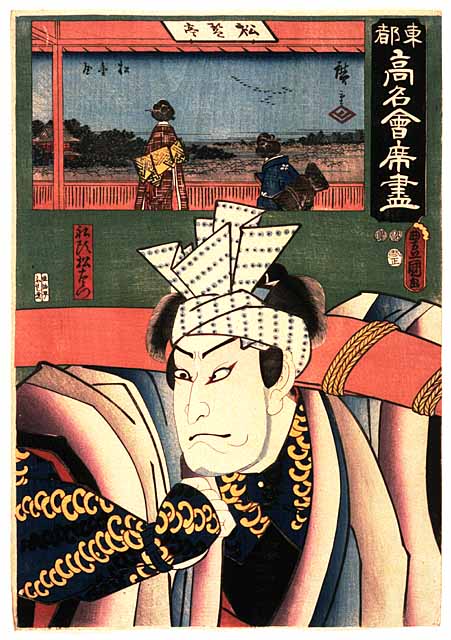
Sendo Matsuemon Shodoya (Matsuemon the Boatman: Shokintei)
01/1853
Given by the Friends of the Fitzwilliam with the aid of the MGC Purchase Grant Fund and the National Art Collections Fund.
Memorial portrait by Kunisada of Nakamura Utaemon IV (who had died in 02/1852) as Matsuemon the Boatman, juxtaposed with a view designed by Utagawa Hiroshige I (1797-1858) of the Shokin-tei Restaurant (named as the Shodoya on the print), from the series Toto (Edo) komei kaiseki-zukushi (All the Famous Restaurants of Edo).
This was one of several series with landscape backgrounds designed to capitalise on the success of the series of prints with views of the Tokaido published in early 1852. Another print from this series, Takeda Katsuyori Koshuya has just been added to the Fitzwilliam Museum’s collection: click on its title to see it.
Portraits of Utaemon IV sold particularly well in the year following his death in 02/1852, as they became part of the wave of memorial portraits (tsuizen-e) to the actor. It is recorded that a portrait of Utaemon IV in Kunisada’s Tokaido series sold in 8,000 impression for this reason (and the publisher held a party to celebrate!).
Collections Record: P.70-1999



